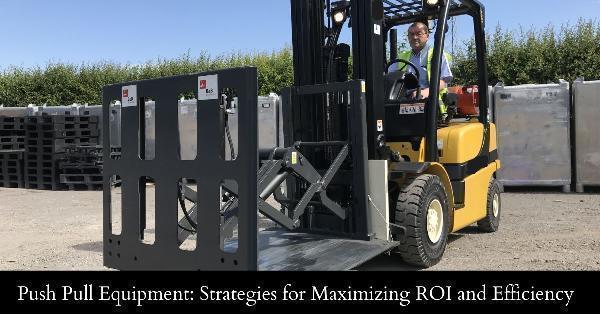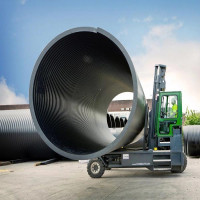Push Pull Equipment: Strategies for Maximizing ROI and Efficiency

Strong 8k brings an ultra-HD IPTV experience to your living room and your pocket.
Introduction:
In the realm of material handling, push pull equipment plays a crucial role in optimizing efficiency and productivity across various industries. From the versatile Power Pusher to the specialized capabilities of Side Loader Forklifts and Pipe Handling Equipment, each type offers unique advantages for streamlining operations. In this article, we delve into strategies for maximizing return on investment (ROI) and efficiency when implementing and utilizing push pull equipment.
Understanding Power Pusher:
The Power Pusher is a highly efficient and versatile device that is designed to push and pull heavy loads with ease. It is equipped with powerful motors and advanced controls that enable it to handle loads ranging from 500 to 50,000 pounds. The compact design of the Power Pusher makes it easy to maneuver in tight spaces, making it ideal for use in manufacturing floors and warehouse settings.
The Power Pusher is equipped with a range of safety features that help to minimize workplace injuries. It has an emergency stop button that can be activated in case of any unforeseen circumstances, and its advanced sensors can detect obstacles and automatically stop the device to prevent collisions.
By leveraging the Power Pusher effectively, businesses can significantly minimize manual labor and the risk of workplace injuries. It is an excellent solution for industries that require a safe and efficient method to move heavy loads. The device can be used to move a wide range of loads, including pallets, heavy machinery, and other bulky items.
Strategies for Side Loader Forklifts:
Side Loader Forklifts are specialized material handling machines that are designed to excel in maneuvering through narrow aisles and handling long or awkwardly shaped loads with precision. They are particularly useful in handling long loads such as pipes, timber, and steel bars. The unique design of side loader forklifts allows them to carry heavy loads along their side, which makes them ideal for working in tight spaces.
To maximize the return on investment with Side Loader Forklift, businesses should invest in comprehensive operator training to ensure that the operators are trained to operate the machine safely and efficiently. They should also implement preventive maintenance schedules to reduce downtime and avoid costly repairs. Regular maintenance can help extend the life of the equipment and improve its overall performance.
In addition, optimizing workflow layouts can help businesses capitalize on the unique capabilities of Side Loader Forklifts. This can include reorganizing the warehouse to reduce travel time and improving the loading and unloading process. By taking advantage of the unique capabilities of Side Loader Forklifts and implementing best practices, businesses can improve productivity, reduce costs, and increase safety.
Optimizing Pipe Handling Equipment:
In various industries, such as construction and manufacturing, the handling of pipes is a crucial and integral part of the daily operations. The effectiveness and efficiency of pipe handling equipment are critical to ensure seamless and safe transportation of pipes from one point to another. Businesses can benefit from investing in durable and adaptable pipe handling solutions, such as adjustable pipe racks and specialized lifting attachments, which can help streamline workflows, minimize downtime, and improve safety measures. With the right pipe handling equipment, workers can handle pipes of various sizes and weights with ease, reducing the risk of accidents and damage to the pipes. In conclusion, the proper pipe handling equipment can be a valuable asset to businesses, providing them with a competitive edge by enhancing their productivity, safety, and profitability.
Integration and Automation:
One of the ways for businesses to increase their efficiency and productivity is to explore the integration and automation opportunities available with push pull equipment. By integrating these systems with warehouse management software (WMS), businesses can enjoy real-time tracking of inventory, optimized routing, and automated replenishment processes.
With the help of push pull equipment, businesses can easily move materials and products around the warehouse, reducing human error and increasing the speed of operations. When combined with WMS, businesses can track inventory levels in real-time and optimize the routing of products, reducing the time it takes to move items from one point to another.
In addition to integrating push pull equipment with WMS, businesses can also incorporate automation technologies such as sensors and robotics to further streamline material handling operations and improve overall efficiency. Sensors can be used to monitor the movement of materials and products, while robotics can help with tasks such as picking and placing items, reducing the need for human intervention and increasing the speed of operations.
Training and Safety Measures:
Ensuring proper training for operators and implementing stringent safety measures are essential components of maximizing ROI with push pull equipment. Comprehensive operator training programs should cover equipment operation, safety protocols, and emergency procedures to minimize the risk of accidents and injuries. Additionally, regular safety audits and equipment inspections help maintain compliance with regulatory standards and ensure a safe working environment.
Conclusion:
Push pull equipment , including Power Pushers, Side Loader Forklifts, and Pipe Handling Equipment, offers immense potential for enhancing efficiency and maximizing ROI in material handling operations. By implementing strategic approaches, investing in training and safety measures, and exploring integration opportunities, businesses can unlock the full potential of push pull equipment to drive productivity and profitability.
In conclusion, adopting a holistic approach to push pull equipment utilization enables businesses to optimize material handling processes, reduce costs, and gain a competitive edge in today's dynamic market landscape.
Note: IndiBlogHub features both user-submitted and editorial content. We do not verify third-party contributions. Read our Disclaimer and Privacy Policyfor details.


